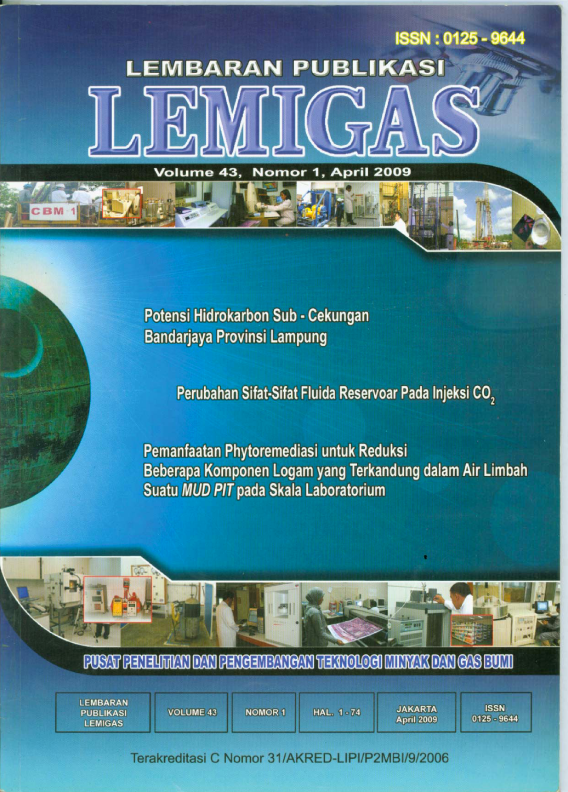Pemanfaatan Phytoremediasi untuk Reduksi Beberapa Komponen Logam yang Terkandung dalam Air Limbah Suatu Mud Pit pada Skala Laboratorium
DOI:
https://doi.org/10.29017/LPMGB.43.1.205Kata Kunci:
PhytoremediasiAbstrak
Suatu penelitian phytoremediasi berskala laboratorium, telah dilakukan untuk mereduksi kandungan logam dalam air limbah dari suatu mud pit. Dalam penelitian ini tanaman air dari spesies Azolla microphylla dan Salvina molesta digunakan sebagai absorbernya. Kedua tanaman tersebut dapat menurunkan kandungan logam dengan cukup baik. Selama 12 hari proses phytoremediasi, tanaman air ini dapat mengabsorp kandungan logam tertinggi sebagai berikut Fe, Pb, Cr, Cu, Cd, Co, Ni, Mn, dan Zn sebesar 85,78%, 79.49%, 78.43%, 66.67%, 53.66%, 44,94%, 36.99%,20.45%, 17.76%.
Referensi
Suthersan, S.S. 2002, Natural and Enhanced Remediation System, Lewis Publishers. Boca, Raton, London, New York. p. 239-268.
Cunningham, S.D.; Shann, J.R.; Crowley, D.E. and Anderson, T.A. 1997, Phytoremediation of contaminated water and soil. In: Kruger, E.L.; Anderson, T.A. and Coats, J.R. eds. Phytoremediation of soil and water contaminants. ACS symposium series 664. Washington, DC, American Chemical Society, p. 2-19.
Flathman, P.E. and Lanza, G.R. 1998, Phytoremediation: current views on an emerg- ing green technology. Journal of Soil Contamina- tion, vol. 7, no. 4, p. 415-432.
Ensley, S.D. 2000, Rational for use of phytoremediation. In: Raskin, I. and Ensley, B.D. eds. Phytoremediation of toxic metals: using plants to clean-up the environment. New York, John Wiley & Sons, inc., p. 3-12.
Brooks, R.R. 1998a, General Introduction. In: R.R. Brooks ed. Plantc that hyperaccumulate heavy metal: their role in phytoremediation, microbiology, archaeology, mineral explora- tion and phytomining. New York, CBA Inter- national, p. 1-14.
Cunningham, S.D.; Berti, W.R. and Huang, J.W. 1995, Phytoremediation of contaminated soil. Trends in Biotechnology, vol. 13, no. 9, p. 393- 397.
Carman, E.P.; Crossman, T.L. and Gatliff, E.G. 1998, Phytoremediation of no. 2 fuel oil contami- nated soil. Journal of Soil Contamination, vol. 7, p. 455-466.
Gordon, M.; Choe, N.; Duffy, J.; Ekuan, G.; Heilman, P.; Muiznieks, I.; Newman, L.; Ruszaj, M.; Shurtleff, B.B.; Strand, S. and Wilmoth, J. 1997, Phytoremediation of trichloroethylene with hybrid poplars. In: Kruger, E.L.; Anderson, T.A. and Coats, J.R. eds. Phytoremediation of soil and water contaminations. Washington, DC, American ChemicalSociety, p. 177-185.
Dushenkov, V.; Kumar, P.B.A.N.; Motto, H. and Raskin, I. 1995, Rhizofiltration: the use of plants to remove heavy metals from aqueous streams. Environmental Science and Technology, vol. 29, p. 1239-1245.
Salt, D.E.; Blaylock, M.; Kumar, N.P.B.A.; Dushenkov, V.; Ensley, D.;Chet, I. and Raskin, I. 1995a, Phytoremediation: a novel strategy for the removal of toxic metals from the environment using plants. Biotechnology, vol. 13, p. 468-474.
Zhu, Y.L.; Zayed, A.M.; Quian, J.H.; De Souza, M. and Terry, N. 1999b, Phytoaccumulation of trace elements by wetland plants: II. Water hya- cinth. Journal of Environmental Quality, vol. 28, p. 339-344.
Kumar, P.B.A.N.; Motto, H. and Raskin, I. 1995b, Rhizofiltration: The use of plants to remove heavy metals from aqueous streams. Environmental Science and Technology, vol. 29, no. 5, p. 1239- 1245.
Berti, W.R. and Cunningham, S.D. 2000, Phytostabilization of metals. In: I. Raskin and B.D. Ensley eds. Phytoremediation of toxic met- als: using plants to clean-up the environment. New york, John Wiley & Sons, Inc., p. 71-88.
Schnoor, J.L. 2000, Phytostabilization of matels using hybrid poplar trees. In: Raskin, I. and Ensley B.D., eds. Phytoremediation of toxic metals: us- ing plants to clean-up the environment. New York, John Wiley & Sons, Inc., p. 133-150.
Prasad, M.N.V. and Freitas, H.M.O. 2003, Metal hyperaccumulation in plants-Biodiversity pros- pecting for phytoremediation technology. Molecu- lar Biology and Genetics, vol. 6, no. 3.
USEPA. 2000, Introduction to Phytoreme- diation, EPA/600/R-99/107, Washington D.C., Februari.
Kumar, P.B.A.N.; Dushenkov, V.; Motto, H. and Raskin, I. 1995a, Phytoextraction: The use of plants toremove heavy metals from soil. Envi- ronmental Science and Technology, vol. 29, no. 5, p. 1232-1245.
Huang, J.W. and Cunningham, S.D. 1996, Lead phytoextraction: Species variation in lead uptake and translocation. New Phytologists, vol. 134, p. 75-84.
Huang, J.W.; Chen, J.; Berti, W.R. and Cunningham, S.D. 1997a, Phytoremediation of lead contaminated soil: role of systhetic chelates in lead phytoextraction. Environmental Science and Technology, vol. 31, no. 3, p. 800-805.
Lasat, M.M.; Fuhrmann, M.;Ebbs, S.D.; Cornish, J.E. and Kochian, L.V. 1998, Phytoremediation of a radiocesium contaminated soil: evaluation of cesium-137 bioaccumulation in the shoots of three plant species. Journal Environmental Quality, vol. 27, no. 1, p. 165-168.
Smith, R.A.H. and Bradshaw, A.D. 1992, Stabi- lization of toxic mine wastes by the use of toler- ant plant populations. Transactions of the Insti- tution of Mining and Metallurgy, vol. 81, A230- A237.











